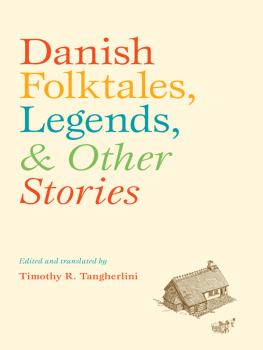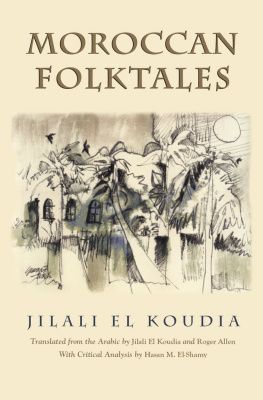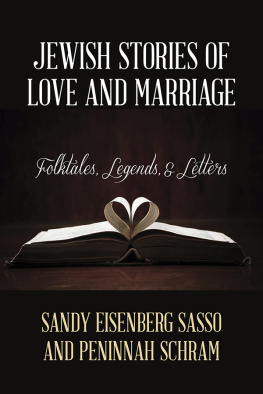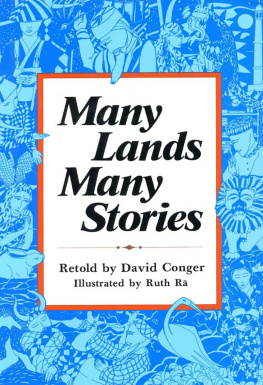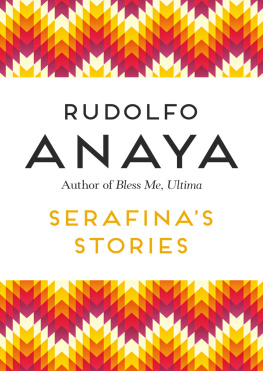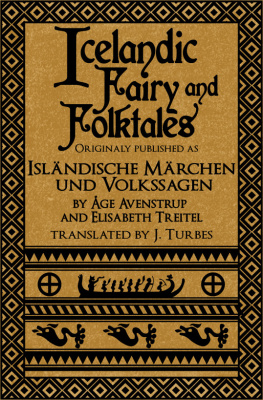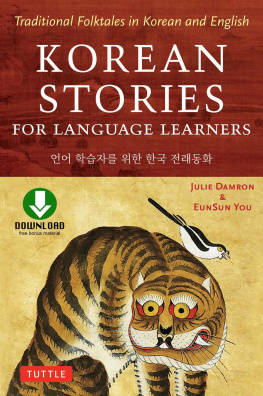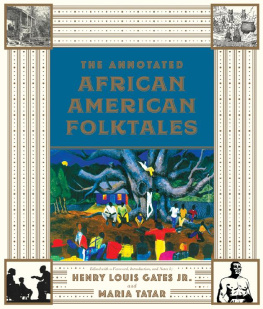Tangherlini - Danish folktales, legends, et other stories
Here you can read online Tangherlini - Danish folktales, legends, et other stories full text of the book (entire story) in english for free. Download pdf and epub, get meaning, cover and reviews about this ebook. City: Dänemark;Denmark;Seattle;Wash, year: 2013, publisher: University of Washington Press, genre: Religion. Description of the work, (preface) as well as reviews are available. Best literature library LitArk.com created for fans of good reading and offers a wide selection of genres:
Romance novel
Science fiction
Adventure
Detective
Science
History
Home and family
Prose
Art
Politics
Computer
Non-fiction
Religion
Business
Children
Humor
Choose a favorite category and find really read worthwhile books. Enjoy immersion in the world of imagination, feel the emotions of the characters or learn something new for yourself, make an fascinating discovery.
- Book:Danish folktales, legends, et other stories
- Author:
- Publisher:University of Washington Press
- Genre:
- Year:2013
- City:Dänemark;Denmark;Seattle;Wash
- Rating:4 / 5
- Favourites:Add to favourites
- Your mark:
- 80
- 1
- 2
- 3
- 4
- 5
Danish folktales, legends, et other stories: summary, description and annotation
We offer to read an annotation, description, summary or preface (depends on what the author of the book "Danish folktales, legends, et other stories" wrote himself). If you haven't found the necessary information about the book — write in the comments, we will try to find it.
Danish folktales, legends, et other stories — read online for free the complete book (whole text) full work
Below is the text of the book, divided by pages. System saving the place of the last page read, allows you to conveniently read the book "Danish folktales, legends, et other stories" online for free, without having to search again every time where you left off. Put a bookmark, and you can go to the page where you finished reading at any time.
Font size:
Interval:
Bookmark:

NEW DIRECTIONS IN SCANDINAVIAN STUDIES
Terje Leiren & Christine Ingebritsen, Series Editors
NEW DIRECTIONS IN SCANDINAVIAN STUDIES
This series offers interdisciplinary approaches to the study of the Nordic region of Scandinavia and the Baltic States and their cultural connections in North America. By redefining the boundaries of Scandinavian studies to include the Baltic States and Scandinavian America, the series presents books that focus on the study of the culture, history, literature, and politics of the North.
Small States in International Relations,
edited by Christine Ingebritsen, Iver B. Neumann,
Sieglinde Gstohl, and Jessica Beyer
Danish Cookbooks: Domesticity and National Identity, 16161901,
by Carol Gold
Crime and Fantasy in Scandinavia: Fiction, Film, and Social Change,
by Andrew Nestingen
Selected Plays of Marcus Thrane, translated and introduced by Terje I. Leiren
Munch's Ibsen: A Painter's Visions of a Playwright,
by Joan Templeton
Knut Hamsun: The Dark Side of Literary Brilliance,
by Monika agar
Nordic Exposures: Scandinavian Identities in Classical Hollywood Cinema,
by Arne Lunde
Danish Folktales, Legends, and Other Stories,
edited and translated by Timothy R. Tangherlini
The Power of Song: Nonviolent National Culture in the Baltic Singing Revolution, by Guntis midchens
The DVD is not available with the e-book, but can be downloaded as a disk image:
http://www.purl.org/danishfolktales/updates.
This publication is supported by a grant from the Scandinavian Studies Publication Fund.
2013 by the University of Washington Press
Printed and bound in the United States of America
Design by Dustin Kilgore
Composed in Hoefler Text, a typeface designed by Hoefler & Frere-Jones
16 15 14 13 5 4 3 2 1
All rights reserved. No part of this publication may be reproduced or transmitted in any form or by any means, electronic or mechanical, including photocopy, recording, or any information storage or retrieval system, without permission in writing from the publisher.
University of Washington Press
PO Box 50096, Seattle, WA 98145, USA
www.washington.edu/uwpress
Published in Europe by Museum Tusculanum Press
Berketinget 6, DK-2300 Copenhagen S, Denmark
www.mtp.dk ISBN 978 87 635 4118 3
DVD 2013 by Timothy R. Tangherlini
The DVD, located at the back of the book, was created by Timothy R. Tangherlini; it incorporates mapping, sophisticated user-driven navigation, and visualization tools that offer readers a rich, immersive experience in the world of Nordic folk narrative.
Library of Congress Cataloging-in-Publication Data
Tangherlini, Timothy R.
Danish folktales, legends, and other stories / Timothy R. Tangherlini.
pages cm. (New directions in Scandinavian studies)
Includes bibliographical references and index.
ISBN 978-0-295-99259-4 (cloth : alk. paper)
1. TalesDenmark. 2. LegendsDenmark. I. Title.
GR210.T35 2013 398.209489dc23 2012051593
The paper used in this publication is acid-free and meets the minimum requirements of American National Standard for Information SciencesPermanence of Paper for Printed Library Materials, ANSI Z39.481984.
ISBN-13: 978-0-295-80556-6 (electronic)
For Isabella and Magnus
THIS BOOK AND ACCOMPANYING DIGITAL CONTENT ARE the end result of a rethinking of standard, published folklore collections. Early in my studies of folklore, I found myself wondering about the people behind the stories I had read. A growing drumbeat in folklore circles seemed to be suggesting that earlier collections were based on suspect premises, in part because of the collecting that lay behind them and in part because of the overt editorial intrusion that intervened between the voice of the teller and the printed page. The implication was clear that early folklore archives were of little use for the study of folk expressive culture. Because I was predominantly interested in the role folklore played in people's understandings of economic, social, and political changes in late nineteenth-century Denmarkand therefore could not undertake my own fieldworkI began hoping that I could somehow recover the connection between storytellers and stories and get back to the important connections that exist in storytelling as a teller moves from one story or song to the next.
While I wrestled with doubts about the legitimacy of existing folklore collections, I struggled with several other frustrations related to the collections. The first frustration was based on the way stories in the early collections were classified. Because most classificatory schemes were more or less idiosyncratic and developed for particular collections or publications, it was difficult to find comparative material either from the same tradition or from other traditions. At the same time, I often found myself wondering why a story appeared in one part of a collection when it could easily have appeared in a different part. The second frustrationwas closely related to the first: because most collections were arranged topically, one had little choice but to base one's study of stories on the existing topic maps and story classifications.
Bengt Holbek's seminal work, Interpretation of Fairy Tales (1987), was an inspiration to me, not so much because of his groundbreaking work on analytical methodologies for the study of fairy tales but because of his thorough work on the archive of Danish folktales compiled by the nineteenth-century collector Evald Tang Kristensen. I based my dissertation and subsequent book, Interpreting Legend (1994), on the archival methods Holbek proposed. My goal was to explore the connections between storytellers and their stories, recognizing that a holistic view of a storyteller's repertoire could lead to a deeper understanding of how individuals use traditionparticularly storytelling traditionas a deep cultural resource as they navigate the challenges of daily life. Unlike my Nordic colleagues, who, starting in the 1960s, had already begun to emphasize the study of individual repertoires as a key to understanding an individual's worldview, I wanted to focus on more than a single individual and a single community. I believe tradition is based on the interactions of many people in large, overlapping groups that span large social and geographical distances, so I needed to focus on the repertoires of many individuals from diverse backgrounds and different parts of the tradition areain this case, Denmark. Ultimately, I decided that the best approach to interpreting folklore was to focus on a large group of individuals and the even larger number of stories that made up their repertoires.
As I began teaching folklore at UCLA, it became apparent to me that along with my students, I was missing a key piece for solving the Nordic folklore puzzle. What we needed was a Nordic folklore collection that included good English translations and thorough archival materials and was predicated on the idea of individuals and their repertoires. Until 1999, when Reimund Kvideland and Henning Sehmsdorf's collection of fairy tales from Nordic storytellers' repertoires, All the World's Reward, appeared, all the available collections of Nordic folklore in English were based on a topic model of folk narrative traditionand even their collection was limited to a single genre, a form of topic modeling in itself. John Lindow's excellent collection of Swedish legends and folktales (1978) isbroken into sections on This World, The Other World, and The World of Religion, and Reidar Christiansen's collection of Norwegian folktales (1964) includes the categories Historical Legends, Legends about Magic and Witchcraft, Legends about Ghosts, the Human Soul and Shapeshifting, and so on. Kvideland and Sehmsdorf's earlier compendium of Scandinavian folk beliefs and legends (1988) is arranged according to a similar topic model. It is difficult to discern in these collections the connections between individual storytellers and their stories. Another glaring problem for a course in Nordic folklore was that not a single substantive collection of Danish folklore existed in English translation.
Font size:
Interval:
Bookmark:
Similar books «Danish folktales, legends, et other stories»
Look at similar books to Danish folktales, legends, et other stories. We have selected literature similar in name and meaning in the hope of providing readers with more options to find new, interesting, not yet read works.
Discussion, reviews of the book Danish folktales, legends, et other stories and just readers' own opinions. Leave your comments, write what you think about the work, its meaning or the main characters. Specify what exactly you liked and what you didn't like, and why you think so.

